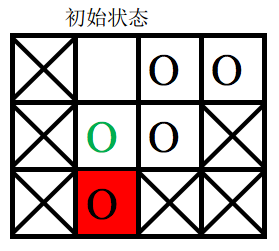描述
小 B 最近迷上了华容道,可是他总是要花很长的时间才能完成一次。于是,他想到用编程来完成华容道:给定一种局面,华容道是否根本就无法完成,如果能完成,最少需要多少时间。
小 B 玩的华容道与经典的华容道游戏略有不同,游戏规则是这样的:
-
在一个 n*m 棋盘上有 n*m 个格子,其中有且只有一个格子是空白的,其余 n*m-1个格子上每个格子上有一个棋子,每个棋子的大小都是 1*1 的;
-
有些棋子是固定的,有些棋子则是可以移动的;
-
任何与空白的格子相邻(有公共的边)的格子上的棋子都可以移动到空白格子上。 游戏的目的是把某个指定位置可以活动的棋子移动到目标位置。
给定一个棋盘,游戏可以玩 q 次,当然,每次棋盘上固定的格子是不会变的,但是棋盘上空白的格子的初始位置、指定的可移动的棋子的初始位置和目标位置却可能不同。第 i 次玩的时候,空白的格子在第 EX_iEXi 行第 EY_iEYi 列,指定的可移动棋子的初始位置为第 SX_iSXi 行第 SY_iSYi 列,目标位置为第 TX_iTXi 行第 TY_iTYi 列。
假设小 B 每秒钟能进行一次移动棋子的操作,而其他操作的时间都可以忽略不计。请你告诉小 B 每一次游戏所需要的最少时间,或者告诉他不可能完成游戏。
格式
输入格式
第一行有 3 个整数,每两个整数之间用一个空格隔开,依次表示 n、m 和 q;
接下来的 n 行描述一个 n*m 的棋盘,每行有 m 个整数,每两个整数之间用一个空格隔开,每个整数描述棋盘上一个格子的状态,0 表示该格子上的棋子是固定的,1 表示该格子上的棋子可以移动或者该格子是空白的。
接下来的 q 行,每行包含 6 个整数依次是 EX_iEXi、EY_iEYi、SX_iSXi、SY_iSYi、TX_iTXi、TY_iTYi,每两个整数之间用一个空格隔开,表示每次游戏空白格子的位置,指定棋子的初始位置和目标位置。
输出格式
输出有 q 行,每行包含 1 个整数,表示每次游戏所需要的最少时间,如果某次游戏无法完成目标则输出−1。
样例1
样例输入1
3 4 2
0 1 1 1
0 1 1 0
0 1 0 0
3 2 1 2 2 2
1 2 2 2 3 2
样例输出1
2
-1
限制
每个测试点1s。
提示
###样例说明
棋盘上划叉的格子是固定的,红色格子是目标位置,圆圈表示棋子,其中绿色圆圈表示目标棋子。
-
第一次游戏,空白格子的初始位置是 (3, 2)(图中空白所示),游戏的目标是将初始位置在(1, 2)上的棋子(图中绿色圆圈所代表的棋子)移动到目标位置(2, 2)(图中红色的格子)上。
移动过程如下:
-
第二次游戏,空白格子的初始位置是(1, 2)(图中空白所示),游戏的目标是将初始位置在(2, 2)上的棋子(图中绿色圆圈所示)移动到目标位置 (3, 2)上。
要将指定块移入目标位置,必须先将空白块移入目标位置,空白块要移动到目标位置,必然是从位置(2,2)上与当前图中目标位置上的棋子交换位置,之后能与空白块交换位置的只有当前图中目标位置上的那个棋子,因此目标棋子永远无法走到它的目标位置,游戏无法完成。
###数据范围
对于 30%的数据,1 ≤ n, m ≤ 10,q = 1;
对于 60%的数据,1 ≤ n, m ≤ 30,q ≤ 10;
对于 100%的数据,1 ≤ n, m ≤ 30,q ≤ 500。
来源
NOIP 2013 提高组 day 2
首先可以考虑全盘爆搜,让空白方块到处乱跑,状态要记录空白方块的位置和目标棋子的位置,所以状态总数为n2m2,时间复杂度为O(n2m2q).
然后来想想优化,当空白方块跑到目标棋子周围时,再到处瞎跑没什么意义而且多个询问棋盘不会改变,所以呢,可以考虑预处理一下当目标棋子的位置为(i, j)时,空白方块在目标棋子a方向时移到b方向最少要的步数。花费一个O(n2m2)的时间去跑nm次bfs。
这有什么用呢?我们先把空白棋子移到目标棋子周围然后就可以跑spfa了,spfa除了记录目标棋子的位置再记录一下空白棋子在哪个方向,转移的时候方向相反,这个距离就可以用之前预处理的结果了。这样总时间复杂度为O(n2m2 + qn2 + kqn2),其中k为spfa的常数。
Code
1 #include<iostream> 2 #include<fstream> 3 #include<sstream> 4 #include<string> 5 #include<cstdio> 6 #include<cstdlib> 7 #include<cstring> 8 #include<ctime> 9 #include<cmath> 10 #include<algorithm> 11 #include<cctype> 12 #include<vector> 13 #include<stack> 14 #include<set> 15 #include<map> 16 #include<queue> 17 #ifndef WIN32 18 #define Auto "%lld" 19 #else 20 #define Auto "%I64d" 21 #endif 22 using namespace std; 23 typedef bool boolean; 24 #define inf 0x3fffffff 25 #define smin(a, b) (a) = min((a), (b)) 26 #define smax(a, b) (a) = max((a), (b)) 27 28 template<typename T> 29 class Matrix { 30 public: 31 T* p; 32 int col, line; 33 Matrix():p(NULL), col(0), line(0) { } 34 Matrix(int line, int col):line(line), col(col) { 35 p = new T[(const int)(line * col)]; 36 } 37 38 T* operator [] (int pos) { 39 return p + pos * col; 40 } 41 }; 42 43 typedef class Point { 44 public: 45 int x; 46 int y; 47 Point(int x = 0, int y = 0):x(x), y(y) { } 48 }Point; 49 50 ifstream fin("puzzle.in"); 51 ofstream fout("puzzle.out"); 52 53 int n, m, q; 54 Matrix<boolean> walkable; 55 int dis[35][35][4][4]; 56 57 inline void init() { 58 fin >> n >> m >> q; 59 walkable = Matrix<boolean>(n, m); 60 for(int i = 0; i < n; i++) 61 for(int j = 0, x; j < m; j++) { 62 fin >> x; 63 if(x) walkable[i][j] = true; 64 else walkable[i][j] = false; 65 } 66 } 67 68 const int mov[2][4] = {{1, -1, 0, 0}, {0, 0, 1, -1}}; 69 70 boolean exceeded(int x, int y) { 71 if(x < 0 || x >= n) return true; 72 if(y < 0 || y >= m) return true; 73 return false; 74 } 75 76 int dep[35][35][35][35]; 77 queue<Point> que; 78 queue<Point> que1; 79 80 boolean vis1[35][35]; 81 int dep1[35][35]; 82 inline int bfs1(Point s, Point t, Point g) { 83 if(s.x == t.x && s.y == t.y) return 0; 84 memset(vis1, false, sizeof(vis1)); 85 dep1[s.x][s.y] = 0; 86 vis1[s.x][s.y] = true; 87 que.push(s); 88 while(!que.empty()) { 89 Point e = que.front(); 90 que.pop(); 91 for(int i = 0; i < 4; i++) { 92 Point eu(e.x + mov[0][i], e.y + mov[1][i]); 93 if(exceeded(eu.x, eu.y)) continue; 94 if(!walkable[eu.x][eu.y]) continue; 95 if(vis1[eu.x][eu.y]) continue; 96 if(eu.x == g.x && eu.y == g.y) continue; 97 dep1[eu.x][eu.y] = dep1[e.x][e.y] + 1; 98 if(eu.x == t.x && eu.y == t.y) { 99 while(!que.empty()) que.pop(); 100 return dep1[eu.x][eu.y]; 101 } 102 vis1[eu.x][eu.y] = true; 103 que.push(eu); 104 } 105 } 106 return -1; 107 } 108 109 inline void init_dis() { 110 for(int i = 0; i < n; i++) 111 for(int j = 0; j < m; j++) 112 for(int p = 0; p < 4; p++) { 113 Point w(i + mov[0][p], j + mov[1][p]); 114 for(int q = 0; q < 4; q++) { 115 Point t(i + mov[0][q], j + mov[1][q]); 116 if(exceeded(w.x, w.y) || exceeded(t.x, t.y)) dis[i][j][p][q] = -1; 117 else if(!walkable[w.x][w.y] || !walkable[i][j] || !walkable[t.x][t.y]) dis[i][j][p][q] = -1; 118 else if(p == q) dis[i][j][p][q] = 0; 119 else dis[i][j][p][q] = bfs1(w, t, Point(i, j)); 120 } 121 } 122 } 123 124 boolean vis2[4][35][35]; 125 int f[4][35][35]; 126 queue<int> que2; 127 inline int spfa(Point s, Point t, Point w) { 128 memset(vis2, false, sizeof(vis2)); 129 memset(f, 0x7f, sizeof(f)); 130 for(int i = 0; i < 4; i++) { 131 Point e(s.x + mov[0][i], s.y + mov[1][i]); 132 if(exceeded(e.x, e.y)) continue; 133 if(!walkable[e.x][e.y]) continue; 134 f[i][s.x][s.y] = bfs1(Point(w.x, w.y), e, Point(s.x, s.y)); 135 if(f[i][s.x][s.y] == -1) f[i][s.x][s.y] = 0x7f7f7f7f; 136 } 137 for(int i = 0; i < 4; i++) { 138 que.push(s); 139 que2.push(i); 140 } 141 while(!que.empty()) { 142 Point e = que.front(); 143 int ed = que2.front(); 144 que.pop(); 145 que2.pop(); 146 vis2[ed][e.x][e.y] = false; 147 for(int i = 0; i < 4; i++) { 148 Point eu(e.x + mov[0][i], e.y + mov[1][i]); 149 int eud = i ^ 1; 150 if(exceeded(eu.x, eu.y)) continue; 151 if(!walkable[eu.x][eu.y]) continue; 152 if(dis[e.x][e.y][ed][i] == -1) continue; 153 if(f[ed][e.x][e.y] + dis[e.x][e.y][ed][i] + 1 < f[eud][eu.x][eu.y]) { 154 f[eud][eu.x][eu.y] = f[ed][e.x][e.y] + dis[e.x][e.y][ed][i] + 1; 155 if(!vis2[eud][eu.x][eu.y]) { 156 vis2[eud][eu.x][eu.y] = true; 157 que.push(eu); 158 que2.push(eud); 159 } 160 } 161 } 162 } 163 int ret = inf; 164 for(int i = 0; i < 4; i++) 165 smin(ret, f[i][t.x][t.y]); 166 if(ret == inf) return -1; 167 return ret; 168 } 169 170 int res = inf; 171 inline void solve() { 172 int wx, wy, sx, sy, tx, ty; 173 while(q--) { 174 res = inf; 175 fin >> wx >> wy >> sx >> sy >> tx >> ty; 176 wx--, wy--, sx--, sy--, tx--, ty--; 177 if(sx == tx && sy == ty) { 178 fout << "0" << endl; 179 continue; 180 } 181 fout << spfa(Point(sx, sy), Point(tx, ty), Point(wx, wy)) << endl; 182 } 183 } 184 185 int main() { 186 init(); 187 init_dis(); 188 solve(); 189 return 0; 190 }

